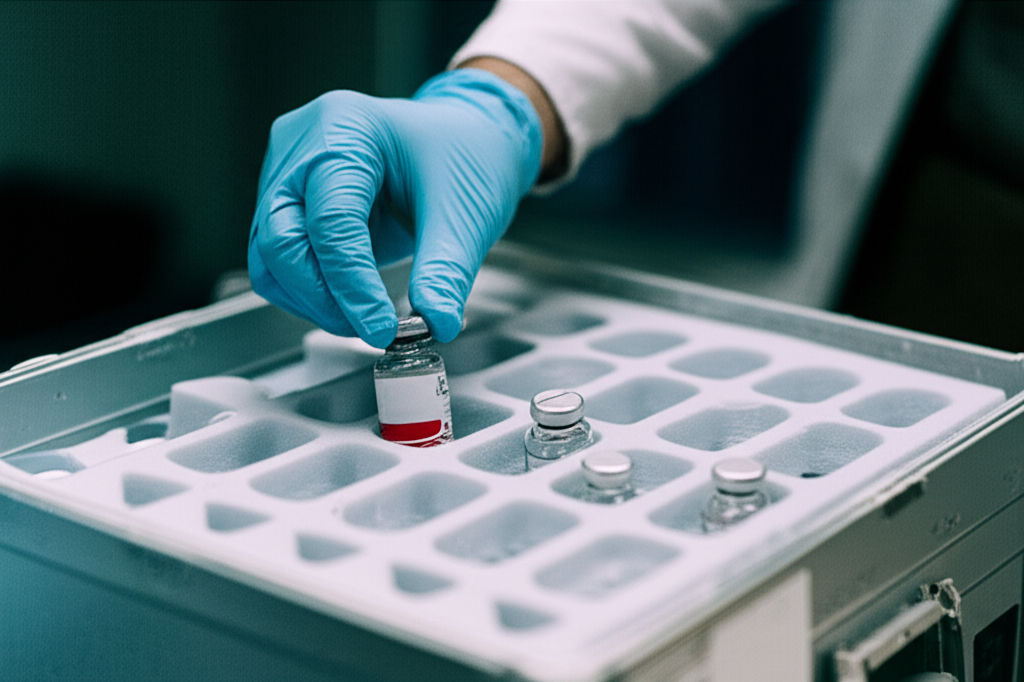Cold Chain Technologies in Supply Management
Ikhsan Rizki

Photo: Explore cold chain technologies: the unsung heroes of supply management. They ensure your food stays fresh and medicine remains potent globally.
Keeping It Cool: How Cold Chain Technologies Revolutionize Supply Management
Imagine biting into a crisp apple that traveled thousands of miles, or receiving life-saving medication that maintained its potency from factory to pharmacy. How is this possible? The unsung hero behind these everyday miracles is cold chain technologies in supply management. Without them, our global supply of food, medicine, and many other sensitive products would be jeopardized.
But what exactly are cold chain technologies, and why are they so critical in today's fast-paced, interconnected world? If you've ever wondered how delicate goods remain perfectly preserved during transit, or how businesses ensure quality and safety from farm to fork, you're in the right place. This article will demystify the world of cold chain management, exploring the innovative technologies that keep our essential goods safe, fresh, and effective.
What Exactly is Cold Chain Management?
At its core, cold chain management refers to the process of managing the temperature of sensitive products from the point of origin to the point of consumption. It's an unbroken series of refrigerated production, storage, and distribution activities that maintain a given temperature range. Think of it as a continuous, temperature-controlled highway for goods that are sensitive to heat or cold.
This isn't just about keeping things "cold"; it's about maintaining a specific temperature range, whether that's freezing, chilling, or simply a controlled room temperature, depending on the product's requirements.
Why are Cold Chain Technologies Essential for Modern Supply Chains?
The importance of robust cold chain technologies cannot be overstated. Their absence or failure can lead to catastrophic consequences, ranging from significant financial losses to severe public health risks.
Protecting Perishable Goods and Preventing Waste
From fresh produce and dairy to seafood and flowers, many products have a limited shelf life and are highly susceptible to spoilage if not kept at the right temperature. Effective cold chain management drastically reduces spoilage, ensuring that more products reach consumers in optimal condition. This not only benefits businesses by cutting down on waste but also contributes to global food security.
Ensuring Pharmaceutical Safety and Efficacy
Perhaps nowhere is the cold chain more critical than in the pharmaceutical industry. Vaccines, insulin, blood products, and many specialized medications require precise temperature control to remain stable and effective. A lapse in the cold chain for these products can render them useless, or worse, harmful. This is why pharmaceutical cold chain integrity is a non-negotiable aspect of healthcare.
Meeting Stringent Regulatory Compliance
Industries dealing with temperature-sensitive goods, especially food and pharmaceuticals, are subject to strict national and international regulations. These rules dictate everything from storage temperatures to monitoring protocols. Implementing advanced cold chain technologies in supply management helps businesses meet these complex compliance requirements, avoiding hefty fines and reputational damage.
Driving Operational Efficiency and Cost Savings
While initial investments in cold chain infrastructure can be significant, the long-term benefits in efficiency and cost savings are immense. By minimizing spoilage, reducing product recalls, and optimizing logistics through real-time data, businesses can achieve substantial operational improvements.
Key Technologies Driving Modern Cold Chains
The evolution of cold chain management has been propelled by remarkable technological advancements. It's no longer just about insulated trucks and refrigerators; it's a sophisticated ecosystem of interconnected systems.
Advanced Refrigeration and Insulation
The backbone of any cold chain remains the refrigeration units themselves. This includes:
- Refrigerated Warehouses: Large-scale storage facilities with precise temperature and humidity controls.
- Refrigerated Transport (Reefers): Trucks, ships, and air cargo containers equipped with cooling systems.
- Specialized Packaging: Insulated containers, gel packs, and phase change materials that maintain temperatures for shorter durations, crucial for "last-mile" delivery.
The Power of IoT and Sensors for Real-Time Monitoring
This is where cold chain management truly enters the digital age.
- Internet of Things (IoT) Sensors: Small, smart devices placed with products or within storage units that continuously monitor temperature, humidity, and even light exposure.
- Real-time Data Transmission: These sensors transmit data wirelessly to a central platform, allowing logistics managers to see conditions instantly, no matter where the shipment is.
- Alert Systems: If temperatures deviate from the set range, automated alerts are sent to relevant personnel, enabling immediate corrective action. This proactive approach is vital for preventing spoilage.
Data Analytics and Predictive Capabilities
Gathering data from IoT sensors is just the first step.
- Big Data Analytics: Sophisticated software analyzes vast amounts of temperature data, identifying patterns, potential problem areas, and opportunities for optimization.
- Predictive Analytics: By analyzing historical data and external factors like weather forecasts, systems can predict potential temperature fluctuations and suggest preventative measures, enhancing the overall cold chain logistics strategy.
Blockchain for Enhanced Transparency and Traceability
Blockchain technology, known for its secure and transparent ledger system, is finding its place in the cold chain.
- Immutable Records: Every temperature reading, every transfer of custody, and every significant event can be recorded on a blockchain, creating an unchangeable audit trail.
- End-to-End Visibility: This allows all stakeholders—from producers to retailers and even consumers—to verify the integrity of the cold chain, building trust and accountability.
Benefits of Implementing Robust Cold Chain Technologies
Investing in and optimizing cold chain technologies in supply management yields a multitude of benefits that extend beyond simply keeping things cool.
- Enhanced Product Quality and Safety: The most direct benefit is ensuring that temperature-sensitive products maintain their quality, efficacy, and safety throughout their journey.
- Reduced Waste and Spoilage: By preventing temperature excursions, businesses significantly cut down on product loss, leading to substantial cost savings and a reduced environmental footprint.
- Improved Compliance and Risk Management: Automated monitoring and data logging simplify adherence to regulatory standards, while real-time alerts help mitigate risks before they escalate.
- Greater Supply Chain Efficiency and Visibility: Data-driven insights from cold chain technologies allow for optimized routes, better inventory management, and a clearer understanding of the entire supply chain's performance.
- Increased Customer Satisfaction and Brand Reputation: Delivering fresh, safe, and effective products consistently builds consumer trust and strengthens a brand's reputation in the market.
Challenges in Implementing Cold Chain Technologies
While the benefits are clear, implementing and maintaining an effective cold chain isn't without its hurdles.
- High Initial Investment: The cost of specialized refrigeration units, IoT sensors, software, and training can be substantial.
- Energy Consumption: Maintaining constant low temperatures requires significant energy, leading to higher operational costs and environmental concerns.
- Complexity of Integration: Integrating various technologies—sensors, software platforms, transport systems—into a seamless, end-to-end cold chain can be technically challenging.
- Global Standardization: Achieving consistent cold chain standards across different countries and regions with varying infrastructure and regulations can be difficult.
- Human Error: Despite technological advancements, improper handling, incorrect temperature settings, or equipment malfunction due to human error can still compromise the cold chain.
Best Practices for Effective Cold Chain Management
Overcoming these challenges requires a strategic approach. Here are some best practices:
- Conduct a Thorough Needs Assessment: Understand the specific temperature requirements of each product and the environmental conditions it will face.
- Invest in Quality Equipment: Prioritize reliable refrigeration, insulation, and monitoring technologies.
- Implement Robust Monitoring Systems: Utilize IoT sensors and real-time data platforms to maintain continuous visibility.
- Develop Clear Protocols and Training: Establish strict standard operating procedures (SOPs) for handling, storage, and transport, and provide comprehensive training to all personnel involved.
- Embrace Data Analytics: Regularly analyze cold chain data to identify inefficiencies, predict potential issues, and drive continuous improvement.
- Partner with Experienced Logistics Providers: Choose partners with proven expertise and infrastructure in temperature-controlled logistics.
- Focus on Continuous Improvement: The cold chain is dynamic. Regularly review and update technologies and processes to adapt to new challenges and opportunities.
Conclusion
Cold chain technologies in supply management are far more than just refrigeration; they are the sophisticated backbone of a global economy reliant on the safe and timely delivery of sensitive goods. From ensuring our food is fresh and our medicines are effective, to reducing waste and enhancing efficiency, these technologies play an indispensable role. As supply chains become more complex and consumer demands for quality and transparency grow, the importance of a robust, technologically advanced cold chain will only continue to rise.
Understanding and leveraging these innovations isn't just a competitive advantage—it's a fundamental requirement for success in many industries today.
Frequently Asked Questions (FAQ)
Q1: What industries rely most heavily on cold chain technologies?
A1: The most prominent industries are pharmaceuticals (vaccines, biologics, insulin), food and beverage (fresh produce, dairy, meat, seafood, frozen goods), and floriculture (flowers and plants). Other sectors like chemicals and certain high-tech components also utilize cold chain for sensitive materials.
Q2: How does IoT specifically help in cold chain management?
A2: IoT (Internet of Things) devices, primarily sensors, provide real-time data on critical environmental factors like temperature, humidity, and location. This allows for continuous monitoring, immediate alerts if conditions deviate, and provides a comprehensive data trail for compliance and analysis, significantly reducing the risk of spoilage or damage.
Q3: Is "cold chain" only about keeping things cold, or does it include other temperature ranges?
A3: While "cold" is in the name, cold chain management encompasses maintaining any specific temperature range required by a product. This can include freezing temperatures (e.g., -20°C or -80°C), refrigerated temperatures (e.g., 2°C to 8°C), or even controlled room temperature (e.g., 15°C to 25°C), depending on the product's stability requirements.
Q4: What are the biggest risks of a cold chain failure?
A4: The biggest risks include significant product spoilage and waste, leading to substantial financial losses for businesses. For pharmaceuticals, a cold chain failure can render life-saving medications ineffective, posing serious public health risks. Additionally, it can lead to regulatory non-compliance, product recalls, and severe damage to a company's reputation.
Business
View All
August 30, 2025
Cast of Mind Your Business Show TodayDiscover the stars of Bounce TV's "Mind Your Business"! Get to know the cast behind the laughs in this hit family comedy series.
Ikhsan Rizki

November 14, 2025
When to Hire a Business Litigation LawyerFacing business disputes? Discover when to hire a business litigation lawyer to safeguard your company's stability, reputation, and finances.
Ikhsan Rizki

October 13, 2025
Real Estate Business Cards That WorkReal estate business cards still work! Learn to create powerful cards that stand out, make connections & boost your real estate business.
Ikhsan Rizki

September 17, 2025
BA A380 Business Class Flight ReviewConsidering BA A380 Business Class? This review covers everything from lounges to seat comfort, helping you decide if Club World delivers a premium flight.
Ikhsan Rizki

September 14, 2025
What Is a Firm in Business TermsConfused by "firm" in business? This article clarifies what a firm is, its types, and how it differs from a company. Master this key term!
Ikhsan Rizki

October 2, 2025
Utah SOS Business Search HelpUnlock crucial business info in Utah! Learn how to use the Utah SOS Business Search for name availability, due diligence, status checks & more.
Ikhsan Rizki
Economy
View AllIs Singapore Airlines Premium Economy worth the upgrade? Dive into the real experience, from priority perks to seat comfort, and decide for your next journey.
Ikhsan Rizki
Is the Chevy Colorado fuel-efficient? Get 2023-2025 MPG ratings, real-world factors, and tips to maximize gas mileage. Make a smart truck choice.
Ikhsan Rizki
Save big on Las Vegas Airport parking! This guide covers LAS economy parking, locations, rates & shuttles for a stress-free, budget-friendly trip.
Ikhsan Rizki
Discover the profound economic impact of the Baby Boomers. Learn how this massive generation shaped consumer trends, labor, and today's economy.
Ikhsan Rizki
Dreaming of Daytona Beach on a budget? The Atlantic Economy Inn offers affordable stays steps from the beach with a pool & free WiFi. Your savvy guide!
Ikhsan Rizki
What is the Low Altitude Economy? Explore this new frontier where drones & air taxis revolutionize delivery, travel, and more above us.
Ikhsan Rizki
Education
View AllSeeking top PreK-8 education? Forest Lake Education Center (FLEC) offers academic excellence, Christian values & holistic growth.
Read MoreNavigate Nicholas County Board of Education updates easily! This guide empowers parents, students & the community to stay informed, advocate, and engage for sch...
Read MoreUnlock your potential in pharmacy! Discover Pharmacy Times CE, your accredited guide to staying current, meeting licensure, and enhancing your practice.
Read MoreUnlock your healthcare career with Mercy Hospital's diverse education programs. From foundational training to advanced residencies, find your path to success.
Read MoreConsidering a pharmacy career? Learn the exact educational journey, from prerequisite courses to the Pharm.D. degree, to become a vital healthcare expert.
Read MoreUnlock the potential of specialized learning at North Education Center. This guide explores tailored programs and a nurturing environment for unique student nee...
Read MoreHealth
View All
November 26, 2025
What Harris Health Smith Clinic OffersSeeking comprehensive healthcare in Houston? Harris Health Smith Clinic provides accessible primary care, specialty access, and patient-centered wellness.
Ikhsan Rizki

September 1, 2025
Start Your Career at Denver HealthYour guide to a fulfilling healthcare career at Denver Health. Discover diverse opportunities, benefits, and how to apply to a leading system.
Ikhsan Rizki

August 22, 2025
Careers at Cone Health Right NowExplore careers at Cone Health! Discover a supportive culture, great benefits, and make a real impact in healthcare. Join a Great Place to Work®.
Ikhsan Rizki

November 5, 2025
Orlando Health Patient Portal InfoTake control of your health! Discover the Orlando Health Patient Portal (MyChart) for easy access to records, appointments & secure messaging.
Ikhsan Rizki

August 9, 2025
In Good Health Sandwich Menu PicksTransform your sandwich into a healthy meal! Learn smart choices for bread, lean protein, and veggies to fuel your body without guilt.
Ikhsan Rizki

November 7, 2025
Primary Health Medical Group Near YouSimplify finding your ideal Primary Health Medical Group. Our guide helps you choose a trusted healthcare partner for comprehensive, long-term well-being.
Ikhsan Rizki
Popular Articles
View All
1
2
3
4
5
6
7
8
9
10
Lifestyle
View All
November 12, 2025
What is lifestyle RP and who plays it
Live a second life! Explore Lifestyle RP, an immersive digital world of realistic characters, social interaction, and unique storytelling. Get started here.

October 28, 2025
What a Lifestyle Lift Really Costs
Considering a mini facelift? Learn the *true* cost beyond the sticker price. Understand all factors for an informed decision on your rejuvenated look.

September 9, 2025
Skyn Condom Size Guide From Lifestyles
Unlock comfort & safety! Our Skyn condom size guide helps you find your perfect fit for enhanced pleasure and peace of mind. Non-latex options too.

August 5, 2025
Beauty and skincare lifestyle tips that work
Unlock radiant skin! Discover proven beauty & skincare lifestyle tips that work from the inside out. Cut through the noise for a natural glow.

November 20, 2025
Best Medical Fields for Lifestyle
Achieve work-life balance in medicine! This guide reveals top medical fields with predictable hours, fewer emergencies, and lower stress for a fulfilling career...

September 20, 2025
Why Barefoot Lifestyle Is Gaining Fans
Reconnect with your natural foundation. Explore the science behind why barefoot living improves foot strength, balance, and overall health.

August 18, 2025
Inside Soul Lifestyle Apartments
Soul Lifestyle Apartments: Redefine urban living with top amenities, vibrant community, and unmatched convenience. Find your ideal modern home.

August 9, 2025
DnD Lifestyle Ideas to Try
Level up your reality! Discover practical, fun ways to infuse your everyday life with D&D magic, from home decor to fashion. Embrace the adventure!
Sports





Travel
View All
November 19, 2025
Where to Travel in August Top Destinations
Where to Travel in August: Your Ultimate Guide to Top Destinations August often presents a unique travel dilemma. On one hand, it's peak summer for many, brimmi...

November 13, 2025
RDR2 fast travel tips and tricks
Tired of long rides in RDR2? Unlock all fast travel methods, from camp upgrades to stagecoaches, and save time exploring the Wild West!

August 22, 2025
Belgium Strikes Affecting Air Travel
Belgian strikes impacting air travel? Discover why & how to navigate disruptions, cancellations, and delays to protect your travel plans.

September 23, 2025
Filling Out a Constructed Travel Worksheet
Unlock stress-free travel! Learn to build a powerful constructed travel worksheet to organize bookings, budgets, and itineraries for seamless adventures.

September 3, 2025
French Rail Strike Travel Advice
Don't let French rail strikes derail your travel plans! Get expert advice to confidently navigate disruptions, stay informed, and enjoy your journey.

August 24, 2025
Breathtaking Travel Destinations Greece
Explore Greece's top travel destinations! From iconic islands like Santorini to majestic mainland sites, discover ancient history, beaches & culture.

















